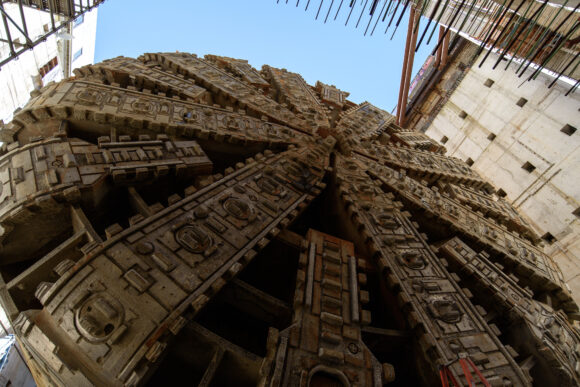The Washington Court of Appeals revived a lawsuit that seeks more than $85 million in damages to a tunnel boring machine that broke down while drilling for a downtown Seattle freeway project.
The three-member appellate panel reversed a portion of a 2018 ruling by the King County Superior Court that dismissed many of the claims in lawsuit filed by Seattle Tunnel Partners and the Washington State Department of Transportation against a group of insurers that issued a builder’s risk policy for the tunnel project.
But the decision, released Tuesday, affirmed the trial court’s rulings that no coverage was owed for costs incurred because of a two-year construction delay or for any damages caused by design defects. It will be up to a jury to decide what caused the breakdown.
The dispute stems from a WSDOT project to replace the Alaska Way Viaduct, a two-level elevated portion of State Road 99 that was damaged in a 2001 earthquake. After deliberating for more than eight years over the design, WSDOT decided to use a “single-bore” tunnel under downtown. In 2011, the state contracted with Seattle Tunnel Partners to design and build the tunnel.
Hitachi-Zosen provided the tool used to drill the 9,270-foot-long tunnel. Nicknamed “Bertha,” the boring machine was 57 1/2 feet in diameter and 357 feet long. It was billed as the largest boring machine ever built at the time.
Bertha began drilling in July 2013 and had dug about 1,000 feet of tunnel when it struck a steel pipe that was used as casing for a groundwater monitoring well, according to press reports. The machine overheated, requiring Seattle Tunnel Partners to drill an access shaft to pull the cutting head up to the surface for repairs, at a cost of $40 million.
WSDOT says the boring machine broke down because of operator error or a design defect. The contractor says the malfunction was caused because of the well casing, which wasn’t noted on the agency’s tunnel plans.
Drilling resumed in 2016 and the tunnel was opened for traffic in February 2019.
Seattle Tunnel Partners and WSDOT filed a claim seeking damages for the cost of repairs and delays, which the insurers denied. The contractor and the state filed suit. The Court of Appeals granted Hitachi permission to join the litigation as an intervenor in Tuesday’s ruling.
According to the appellate court’s opinion, a sublimit in the policy limited coverage for damage to Bertha to $85 million “per occurrence.” A separate section of the policy covered damage to the tunnel, with a limit of $12.5 million.
Hitachi said in pleadings that damages exceeded $85 million.
The King County court granted partial summary judgment in favor of the insurers on several issues. The appellate court granted review on three questions:
- Whether WSDOT and Seattle Tunnel Partners can collect under Section 1 of the policy, which covers damages to the tunnel.
- The meaning of the term “any item” in a mechanical breakdown exclusion in Section 2 of the policy, which covers damage to the tunnel boring machine.
- Whether the policy covered damages caused by delay costs.
The appellate panel ruled in favor of the insurers on two of those questions, finding that there was no damage to the tunnel because of the breakdown and the policy clearly excluded delay costs.
But the panel found that the trial court erred in interpreting the meaning of “any item” in the policy.
The mechanical breakdown exclusion excluded compensation for “loss of or damage in respect any item by its own explosion mechanical or electrical breakdown, failure breakage or derangement,” the opinion says. However, the policy also states that the “exclusion does not apply to resultant damage to the property.”
The trial court found that “any item” means the entire tunnel boring machine, but the appellate court found that the term actually means individual parts of the boring machine, not the entire apparatus. The intent of the policy language was to exclude coverage for “internal causes of damage,” the opinion said.
But there was still a question of whether the damages claimed were to the tunnel or the boring machine. The trial court had granted summary judgment in favor of the insurers finding that 24 categories of damages were clearly related to the tunnel and therefore not covered.
The appellate court, however, found that there is room for argument about seven of those categories, meaning the coverage question should be left to a jury. Specifically:
- The cost of engineering and design consultants for construction of the access shaft.
- Costs associated with a city of Seattle project services agreement, in which Seattle provided various support functions.
- Costs associated with extending leases with the Port of Seattle for warehouse space to store project equipment.
- Costs associated with WSDOT’s supervision of the excavation of the access shaft.
- Costs associated with moving electrical utilities that conflicted with the location of the access shaft.
- Costs associated with WSDOT’s supervision of the excavation of the access shaft.
- Costs associated with change orders that arose because of the construction of the access shaft.
On the other hand, the appellate panel refused to allow WSDOT to pursue its claim for the cost of replacing windows at nearby condominium buildings to provide better soundproofing because of the noise generated during construction of the access shaft. The court said the agency submitted no documents showing that the expense of replacement windows was necessary to repair the tunnel boring machine.
About the photo: The cutter head for Bertha, at the time the world’s largest tunnel boring machine, is shown in a photo provided by WSDOT.
Was this article valuable?
Here are more articles you may enjoy.


 CoreLogic Report Probes Evolving Severe Convective Storm Risk Landscape
CoreLogic Report Probes Evolving Severe Convective Storm Risk Landscape  Harvard Study Again Stirs the Pot on Demotech Ratings of Florida Carriers
Harvard Study Again Stirs the Pot on Demotech Ratings of Florida Carriers  Beyond the Claim: How Social Canvassing is Transforming Insurance Fraud Detection
Beyond the Claim: How Social Canvassing is Transforming Insurance Fraud Detection  California Chiropractor Sentenced to 54 Years for $150M Workers’ Comp Scheme
California Chiropractor Sentenced to 54 Years for $150M Workers’ Comp Scheme 